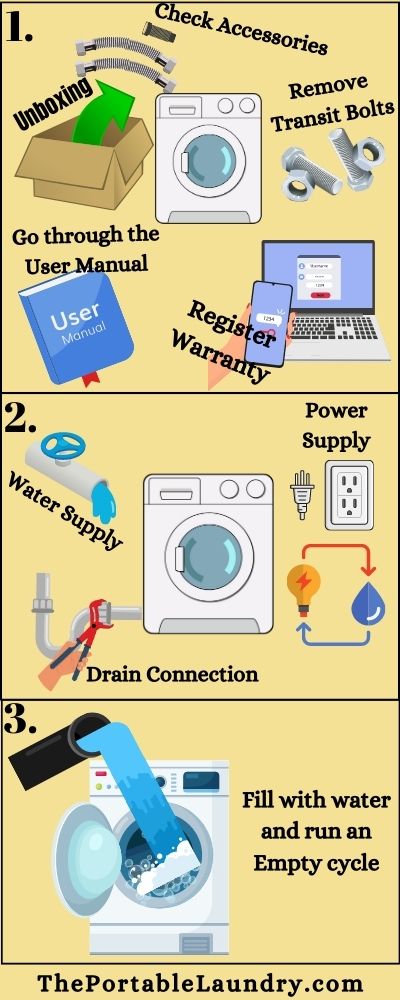Let’s be honest, It’s super tempting to use any new appliance OR gadget that arrives at your doorstep.
The feeling of unboxing a new product and using it for the first time is euphoric.
But before you start using the washer right away, you should not ignore the fact that your appliance may have residual remains from the manufacturing process.
Most manufacturers test the product before packaging and shipping so it’s likely that it may still contain water residues from tests.
So should you run a new washing machine empty first?
Let’s try to clear the confusion around this topic.
Here’s what this article covers.
Table of Contents
Let’s dive right into it.
Illustration showing how to run a new washing machine

What is the purpose of an empty cycle?
The main purpose of an empty cycle is to clean the machine. It’s mainly used to remove any residual detergent, fabric softener, or other materials that might be left behind post completing the wash cycle.
So, when we talk about running the washing machine empty the first time you use it, we’re really just talking about running it without any clothes or other materials in it.
Running an empty cycle helps to get rid of leftover materials that were used during the manufacturing process and also allows you to test the basic functions.
How to Run an Empty Cycle?
Once you have brought a new washing machine, you need to install it properly.
So, make sure the location of the washer is set according to the drainage and water supply system.
After the installation is complete, you can start the empty cycle.
To run an empty cycle for the first time (or any time), simply select the ’empty cycle’ option on your washing machine.
This will typically involve selecting a ‘rinse only’ or ‘spin only’ option.
Once you’ve selected the appropriate setting, just hit start and let the washer complete the empty wash cycle.
Since you are using your brand new washing machine for the first time, it’s recommended not to pour any detergent OR fabric softeners.
Just let the washer complete the empty cycle using plain water.
Note: If your washer does not have an empty cycle, you may run Quick Wash OR Normal Cycle without any laundry load in it.
Will Empty Cycle Damage Washing Machine?
No, an empty cycle will not damage your washing machine.
In fact, it’s actually recommended that you run an empty cycle from time to time even if you’re not using a brand-new washing machine.
This is because it helps to keep the washer clean and free of any residual materials that might be left behind after completing a wash cycle.
Is it necessary to run an empty cycle on a new washing machine?
Yes, when you first use a new washing machine, it’s recommended that you run an empty cycle.
This helps to remove any residual materials and water from the manufacturer’s tests.
In fact, Samsung recommends running an empty cycle before you wash your clothes for the first time (1).
Furthermore, an empty cycle also allows you to test the basic functions of the washer without having to put any laundry in it.
How do you prepare a new washing machine?
In order to prepare a new washing machine, you need to install it properly and then run an empty cycle.
Follow the below steps to prep your new washing machine
Inspect the Box
Make sure the box is in good condition and there should not be any visible damage. Ensure checking the dents and scratches on the box.
Check if all the accessories
Make sure that you check all the accessories in the box.
Check the Model Number and Serial Number of the machine. These numbers will be required while registering the product warranty.
Register the Warranty
It is always recommended to register the warranty of your appliance as soon as you buy it. This will help you in case any issue arises with the product within the warranty period.
Check the Manual
Familiarize yourself with the owner’s manual before you start using the machine.
Make Necessary Plumbing Arrangements
If you are doing the installation yourself, then make sure you have all the necessary plumbing tools with you.
Turn Off the Water Supply
Once you have everything ready, it’s time to turn off the water supply. This step is very important as you don’t want any water leaking while installing the washing machine.
Install it Properly
Installing a washing machine properly is important in order to ensure that it functions correctly and doesn’t cause any damage to your home.
To install a washing machine, you first need to find a suitable location.
This location should be close to a water source and a drainage system.
Once you’ve found a suitable location, simply install the washer by following the user manual.
If you’re not sure how to install a washing machine, it’s best to consult the owner’s manual or call a professional.
Get Rid Of Transit Bolts
The transit bolts are used to secure the washer during transportation and they need to be removed before using the appliance.
So, it’s important that you gid rid of transit bolts and washer legs as soon as the washer reaches your home.
If you don’t remove the transit bolts, it can cause serious damage to your washing machine.
To remove the transit bolts, simply look for them at the back of the washer and unscrew them using a wrench.
As for the washer legs, they can be found at the bottom front of the machine.
To remove them, simply unscrew them using your hands.
Connect the Water Hoses & Power Cables
The Next step is to connect the water hoses and power cables.
For this, you need to refer to the user manual as different models have different instructions.
In general, the cold water hose is connected to the back left side of the washer while the hot water hose is connected just next to the cold water hose. In some cases, a hot water hose may be located on the back right side.
Again, the hose location may vary drastically depending on the washer type, size, and model.
As for the power cables, they need to be connected to a power outlet.
Note: Make sure that the power outlet is properly grounded before connecting the power cables.
Fill Up The Washer With Water
Once you’ve connected the water hoses and power cables, you need to fill up the washer with water.
To do this, simply turn on the water faucets and let the water flow into the machine.
Just make sure that you don’t fill up the washer more than three-quarters full as this can cause problems during the washing cycle.
Run an Empty Cycle
After filling up the washer with water, you need to run an empty cycle.
This will help to remove any water residues that may be there from the manufacturer’s tests.
If your washer does not have an empty wash OR clean function, simply run a normal cycle using mild detergent.
The cycle time may vary depending on the washing machine but it’s generally around 30 minutes.
When you buy a new washing machine do they take the old one?
It completely depends on the scheme under which you are buying a new washing machine.
Some retailers might offer you an exchange scheme where they will take away your old washing machine and give you a discount on the new one.
There are other retailers who might not offer this facility. It is best to check with the retailer before making your purchase.
Final Thoughts
Running an empty cycle the first time helps in many ways.
It not only gets rid of residual remains from the manufacturing process but also helps to test the basic functions of your washing machine.
If your washing machine doesn’t have an empty wash function, simply run a normal cycle using mild detergent.
Just make sure that you don’t fill up the washer more than three-quarters full.
Lastly, don’t forget to check the instruction manual or contact a professional if you need help installing your new appliance.
You May Also Like
- What is a Washing Machine Standpipe? (Explained)
- What is Extra Rinse in Washing Machine?
- What is a Smart Washer and Dryer? (Explained)
- What is an Agitator in Washing Machine?
- What is a Lint Filter in Washer? (10 Things you must know)
- What is Soil Level in Washing Machine?
- What Is RPM in Washing Machine? (13 Things to know)
- What Is Rinse And Spin In LG Washing Machine?
- What is IE Error in LG Washing Machine? (And Solutions)
- What is a Water Booster Pump in Washing Machine? (Explained)
- What is the Allergiene cycle in an LG washer? (Explained)

